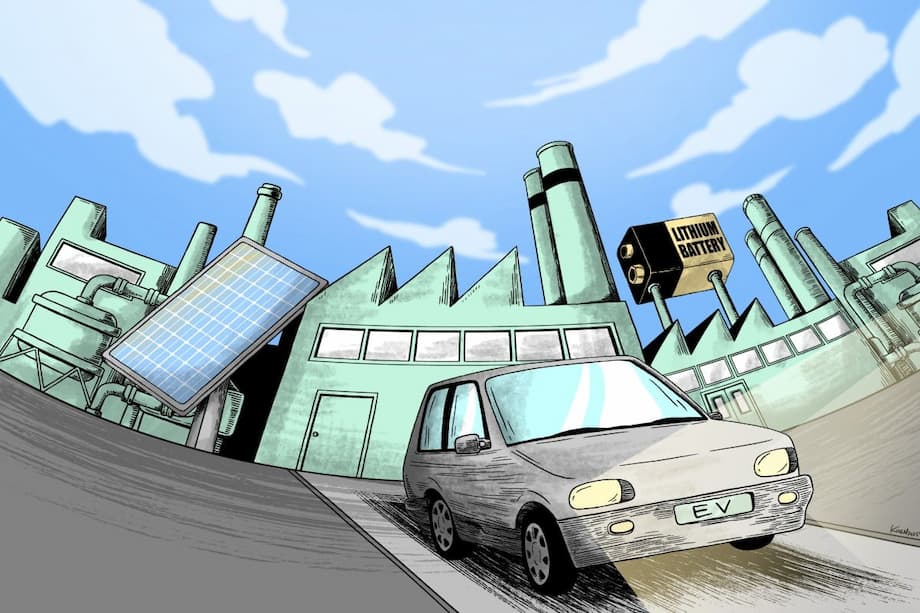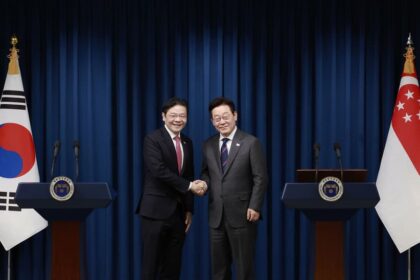Inside China’s cleaner growth push
Across two decades of fieldwork and policy shifts, China has moved from crisis management to large scale environmental repair. In 2006, Ma Jun, founder of the Beijing based Institute of Public and Environmental Affairs, documented that around 28 percent of monitored water sources were severely polluted, leaving nearly 300 million people without sufficient safe drinking water. Today, national control sections report more than 90 percent of monitored water graded as excellent, good, or fair. Air quality has improved alongside the water turnaround. From 2015 to 2022, nationwide annual average PM2.5 levels fell by about 35.6 percent, a drop comparable to the gains the United States achieved over roughly three decades under the Clean Air Act. PM2.5 refers to fine particles that can lodge deep in the lungs and enter the bloodstream, raising risks of heart and respiratory disease. A sustained decline in PM2.5 translates into fewer hospital admissions, longer life expectancy, and measurable gains in productivity.
- Inside China’s cleaner growth push
- What turned the tide: policy, technology, and industry alignment
- Factories as part of the solution
- What the research shows about cutting pollution and carbon at the same time
- Regions that moved fastest, and why
- Water cleanup and the long arc of enforcement
- What challenges remain
- What it means abroad
- Key Points
This cleaner air did not come from closing factories en masse. It came from a deliberate push to pair industrial expansion with tighter rules, real time monitoring, and rapid deployment of clean technologies. The picture that emerges from academic studies and on the ground progress is a form of industrialization driven decarbonization. Heavy investment in renewables, electric transport, and digital control systems has allowed output to rise while emissions and pollutants trend downward in many regions.
Research from Chinese cities and provinces shows why the trajectory changed. Stronger environmental rules channeled funds into research and development, public databases increased compliance pressure, and new equipment made it cheaper to cut emissions per unit of output. Manufacturing itself became a delivery mechanism for cleaning the air and water, as firms scaled solar panels, wind turbines, batteries, advanced motors, and waste treatment systems. The result is cleaner growth backed by data rather than a contraction of industry.
What turned the tide: policy, technology, and industry alignment
The progress rests on a three part alignment. First, regulators tightened standards and created economic penalties for pollution. Second, a vast monitoring and disclosure system made emissions visible to officials, companies, and the public. Third, industry invested in cleaner production and products, supported by a surge in domestic innovation and supply chain scale.
Real time monitoring and transparency
China built dense networks of continuous emissions monitoring at power plants and smokestack industries, coupled with city level air quality stations and national water monitoring points. Public pollution maps and disclosure platforms give citizens, investors, and downstream buyers visibility into factory performance. This data layer, reinforced by satellite observations and audits, makes it harder to hide violations and easier to reward compliant operators. For many firms, meeting buyer requirements at home and abroad now depends on documented environmental performance.
Transparency and enforcement go hand in hand. Data driven inspections identify outliers quickly. Automated controls shut down illegal discharges. Provinces compare performance on clear metrics, from days with good air quality to wastewater compliance rates. In this environment, clean technology becomes a cost saving compliance tool instead of a burden.
Standards, taxes, and performance targets
Economic incentives reinforced the monitoring push. A nationwide environmental protection tax replaced pollution fees in 2018. A recent study using a difference in differences approach across 287 cities found the tax led to a 5.63 percent reduction in regional carbon emissions. It worked through increased investment in green research and development, better energy efficiency, and industrial upgrading. The policy also cut conventional air pollutants, with gains most evident in eastern regions and energy intensive areas where enforcement and fiscal capacity are stronger.
City level performance targets and demonstration programs sharpened the focus on innovation. Evaluating the energy saving and emission reduction demonstration city policy as a quasi natural experiment, researchers found it significantly boosted urban green technology innovation from 2006 to 2019. The effect was strongest in cities with stricter environmental goals and in places that increased fiscal support for science and technology. Innovation, in turn, reduced carbon emissions and improved air quality by pushing cleaner energy use and upgrading industrial structure.
Regional coordination is also shaping outcomes. In the Yangtze River Economic Belt, policies that align standards across provinces and share technology and know how have accelerated joint gains in pollution control and carbon reduction. This works through three channels: shifting local industry toward cleaner segments, speeding the transition to cleaner energy, and spreading low carbon technologies through networks of cities and firms.
Factories as part of the solution
China’s industrial capacity has become a powerful engine for the global clean energy build out. According to recent analyses of the global market, China accounted for about 60 percent of the world’s electric vehicle battery market, commissioned as much solar capacity in 2023 as the entire world installed the previous year, and delivered roughly three quarters of global wind farm installations in that same year. These volumes cut the cost of green technologies, making them more accessible from Asia to Africa to the Americas. The effect can be seen in supply chains as far as New Zealand, which sourced about 89 percent of its solar photovoltaic gear from China in 2023, and in African villages where low cost panels power off grid clinics and schools.
Clean electricity as the foundation
Rapid additions of wind and solar are shifting the power mix toward cleaner sources. The scale of recent activity is unmatched, with new solar parks stretching across deserts and rooftops, and offshore turbines rising along the coast. Costs have fallen, construction timelines have shortened, and local content rules have cultivated domestic suppliers across every major component. Grid integration remains a challenge. Curtailment risks, limited flexibility in coal heavy regions, and transmission bottlenecks can waste clean generation during peak production hours. Investment in long distance transmission, pumped hydro and battery storage, and smarter dispatch is easing these constraints step by step.
Batteries, transport, and new industrial models
Battery capacity is transforming transport and buildings. Domestic cities run large fleets of electric buses and taxis, and Chinese firms export compact electric cars, trucks, and buses to markets from Southeast Asia to Latin America. Industrial plants have started to reinvent operations around low emissions. In Sichuan, a showcase zero carbon factory uses sensors and artificial intelligence to optimize energy use, cutting emissions by hundreds of thousands of tons each year. Hydrogen projects are also scaling, with the country hosting one of the largest green hydrogen facilities and a substantial share of global refueling stations. These systems are not only domestic solutions, they also feed export industries that deliver clean equipment worldwide.
What the research shows about cutting pollution and carbon at the same time
A growing body of peer reviewed work explains how policy and technology translate into cleaner air and lower greenhouse gases. One study using panel data from 2008 to 2021 finds that green technology innovation in industry drives cleaner development by pushing an upgrade in industrial structure. Green process and product innovations are the strongest drivers. They cut conventional pollution and carbon intensity together by changing how firms operate and what they produce, with the effects varying across regions.
Urban studies show similar patterns. Using data from 272 cities through 2022, researchers found that green technology innovation significantly reduces urban carbon emissions. The mechanism runs through environmental regulation and the energy consumption structure. Stronger rules and a shift toward cleaner energy both act as mediators and also work in sequence, tightening the link between innovation and lower emissions. The effect is most pronounced in eastern, larger, and non resource based cities, where capacity to implement complex policies tends to be higher.
Air pollution responds in distinct ways across pollutants and regions. A recent analysis of the Yangtze and Yellow River basins separates innovation quantity from innovation quality. It finds that the number of green patents and the share of high value patents each affect PM2.5 and PM10 differently, and that the relationships are nonlinear. As innovation increases, PM10 often declines sooner. PM2.5 improves more slowly and benefits most when a larger share of patents are high value, signaling that moving from many ideas to better ideas matters for the finest particulates that pose the greatest health risks.
Another line of research tracks broader capacity to cut carbon at the provincial level. From 2006 to 2021, Chinese provinces increased their carbon reduction capacity, with leaders in the east, rising performance in central regions, and catch up in the west. Green innovation showed both direct effects and positive spillovers to neighboring provinces, and the benefits grew stronger above certain thresholds. That finding matches earlier work on air pollution that identified spatial spillovers and threshold effects tied to the strength of environmental regulation. In plain terms, green innovation has wider benefits when rules are clear and firm, and when the network of cities reaches a critical mass of capability.
Finally, studies of taxes and institutional reforms provide practical lessons. The environmental protection tax reduced carbon emissions while improving air quality and well being. Free trade pilot zones, a marker of institutional openness, improved joint progress on air quality and carbon reduction within the zones by promoting industrial upgrading, energy efficiency, and innovation. At the same time, some neighboring cities saw negative spillovers, underscoring the need for coordination when growth shifts across local borders.
Regions that moved fastest, and why
Progress has been uneven, and the reasons are instructive. Eastern cities typically advanced faster because they combined stronger enforcement, deeper scientific and engineering talent, and better access to finance. Institutional openness reinforced these advantages. Cities designated as free trade pilot zones saw bigger combined gains on air and carbon outcomes, supported by industrial structure upgrades, more efficient energy use, and a push for green innovation. Administrative efficiency and public environmental awareness amplified the impact.
Where firms or investment moved across boundaries, some gains were offset by pollution relocating to nearby areas. That pattern explains why cross border coordination matters. In the Yangtze River Economic Belt, shared standards and joint programs have improved results over time. The approach treats clean industry as a common project rather than a competitive advantage to be pursued in isolation.
Water cleanup and the long arc of enforcement
Water quality gains reflect years of investment and enforcement. Cities expanded wastewater treatment, added nitrogen and phosphorus removal, and upgraded sludge handling. Industrial clusters consolidated into parks with centralized treatment and sharper oversight. Small highly polluting plants closed or retooled. Monitoring now spans river basins, from headwaters to major control sections, with national grading that feeds into local performance assessments. The upshot is that more than nine in ten monitored water sections now meet at least a fair standard, a turnaround from the mid 2000s when severe contamination was widespread.
Air and water programs have moved together since 2013, when a new wave of policies set binding targets and funded cleaner energy and pollution control. The Yellow River Basin, long more polluted than the Yangtze, has seen declines in particulates and improved wastewater treatment coverage, though industrial structure and winter heating still pose challenges. Steady investment, transparent reporting, and tighter permits for discharge and emissions remain central to keeping the gains.
What challenges remain
China’s energy system still leans on coal for reliability, especially during peaks and dry seasons. Integrating higher shares of wind and solar requires more flexible generation, long duration storage, better regional dispatch, and demand management in industry and buildings. These steps reduce curtailment and allow clean power to displace fossil generation without compromising reliability.
Heavy industry is another frontier. Steel, cement, and chemicals are harder to decarbonize because processes rely on high temperature heat and chemical reactions that emit carbon. Pilot projects are testing green hydrogen for steelmaking, electric kilns, carbon capture at cement plants, and high efficiency electrified equipment. Bringing costs down will take larger scale demonstrations, standardized designs, and reliable clean power to run new equipment.
Manufacturing the clean energy equipment itself carries an environmental footprint. Life cycle studies show that panels, batteries, and wind components still involve emissions and resource use during mining and manufacturing. The trend is moving in the right direction as factories adopt cleaner power, recycle more materials, and improve efficiency, yet continued progress is essential. Policy needs include tight enforcement to avoid pollution havens, mechanisms to address negative spillovers across city borders, and safeguards that keep data quality high. Confidence in the monitoring data is a precondition for markets and communities to trust that measured gains are real.
What it means abroad
China’s scale has lowered global costs for clean energy, speeding adoption worldwide. Chinese solar panels light rural schools in Zimbabwe, while affordable electric vehicles fill streets from Bangkok to Mexico City. Imports of solar equipment from China helped countries like New Zealand expand clean power quickly. For partners, the opportunity lies in combining accessible prices with strong standards, verification, and transparency. Clear procurement rules and disclosure of factory emissions can build trust and ensure that imported clean technologies are aligned with climate and air quality goals.
Capital markets are adapting to this shift. Analysts expect environmental, social, and governance aligned strategies to reach tens of trillions of dollars by 2030. Exchanges are updating listing rules and expanding green finance products to connect investors with manufacturers of batteries, solar materials, and other enabling technologies. Commodity markets are updating rules on responsible sourcing for metals critical to clean energy. Policymakers in developing economies can draw on the Chinese experience by pairing clear standards with investment in monitoring, supporting local innovation, and coordinating across regions to prevent pollution relocation.
Key Points
- National water monitoring shows more than 90 percent of control sections now meet at least a fair standard, a major shift from widespread severe pollution in 2006.
- Average annual PM2.5 levels fell by about 35.6 percent from 2015 to 2022, comparable in scale to three decades of gains in the United States under the Clean Air Act.
- Real time monitoring and public disclosure raised compliance, while clean technologies turned environmental rules into cost saving tools for industry.
- The environmental protection tax cut regional carbon emissions by about 5.6 percent and improved air quality by driving research and development, efficiency, and industrial upgrading.
- Demonstration city programs strengthened urban green technology innovation, especially where environmental targets were strict and public science funding increased.
- Coordinated policies in the Yangtze River Economic Belt accelerated joint progress in pollution control and carbon reduction via cleaner industry, cleaner energy, and wider technology diffusion.
- China’s factories scaled clean tech globally, installing record solar and wind at home, leading in batteries, and lowering costs for countries that import these products.
- Research finds that the quality of green innovation matters for PM2.5, and that benefits spread to neighboring regions when regulation is strong and innovation crosses key thresholds.
- Eastern and more open cities advanced faster, but some neighboring areas saw negative spillovers, highlighting the need for cross border coordination.
- Key challenges include reducing coal dependence in the power system, decarbonizing heavy industry, and cutting the footprint of clean tech manufacturing itself while keeping data quality and enforcement strong.












